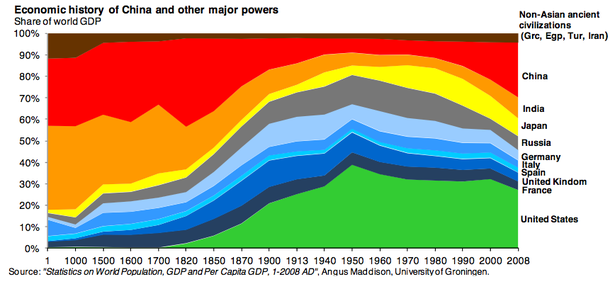Update: Read Part II and Part III
That headline is a big promise. But here it is: The economic history of the world going back to Year 1 showing the major powers' share of world GDP, from a research letter written by Michael Cembalest, chairman of market and investment strategy at JP Morgan.
I'm guessing that your first question, if you started scanning from the left, is: Wait, India was by far the biggest economy at the dawn of AD? Yup, India.
In Year 1, India and China were home to one-third and one-quarter of the world's population, respectively. It's hardly surprising, then, that they also commanded one-third and one-quarter of the world's economy, respectively.
Before the Industrial Revolution, there wasn't really any such thing as lasting income growth from productivity. In the thousands of years before the Industrial Revolution, civilization was stuck in the Malthusian Trap. If lots of people died, incomes tended to go up, as fewer workers benefited from a stable supply of crops. If lots of people were born, however, incomes would fall, which often led to more deaths. That explains the "trap," and it also explains why populations so closely approximated GDP around the world.
The industrial revolution(s) changed all that. Today, the U.S. accounts for 5% of the world population and 21% of its GDP. Asia (minus Japan) accounts for 60% of the world's population and 30% of its GDP.
So, one way to read the graph, very broadly speaking, is that everything to the left of 1800 is an approximation of population distribution around the world and everything to the right of 1800 is a demonstration of productivity divergences around the world -- the mastering of means of manufacturing, production and supply chains by steam, electricity, and ultimately software that concentrated, first in the West, and then spread to Japan, Russia, China, India, Brazil, and beyond.
(via Paul Kedrosky)
We want to hear what you think about this article. Submit a letter to the editor or write to letters@theatlantic.com.

